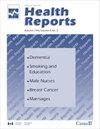2018年加拿大短期癌症患病率
IF 3.3
2区 医学
Q2 PUBLIC, ENVIRONMENTAL & OCCUPATIONAL HEALTH
引用次数: 0
摘要
背景癌症作为加拿大的主要死因,给加拿大人的健康和加拿大医疗保健系统带来了巨大的负担。这项研究根据性别、年龄组、癌症类型和截至1月1日的患病时间,对加拿大癌症患病率进行了详细的肿瘤估计,2018年。数据和方法根据加拿大癌症登记处的发病率数据和加拿大生命统计-死亡数据库的死亡率数据以及税收数据中的死亡相关信息,计算了加拿大人口(魁北克除外)中广泛的癌症列表的两年和五年癌症患病率估计。结果癌症2年和5年患病率分别为236785(每100000人832.1)和503060(每10万人1767.8)。癌症患病率估计值因癌症部位而异,四种最常见的癌症(乳腺癌、前列腺癌、结直肠癌、肺癌)占加拿大癌症五年患病率的49.6%。所有癌症的患病率随着年龄的增长而急剧增加:74.3%的男性和61.9%的女性患病率发生在60岁及以上的人群中。60岁之前女性的患病率高于男性,之后男性的患病率更高,在80-89岁年龄组达到峰值。解释患病率反映了癌症发病率和生存率的影响。按疾病持续时间划分癌症患病率有助于区分处于不同护理阶段的患者群体。患病率的增加表明对医疗保健服务的需求增加,并转化为负责提供此类服务的司法管辖区的重大经济负担。本文章由计算机程序翻译,如有差异,请以英文原文为准。
Short-term cancer prevalence in Canada, 2018.
BACKGROUND
As the leading cause of death in Canada, cancer imposes an enormous burden on both the health of Canadians and the Canadian health care system. This study presents detailed tumour-based cancer prevalence estimates in Canada by sex, age group, cancer type and prevalence duration as of January 1, 2018.
DATA AND METHODS
Estimates of two- and five-year cancer prevalence were calculated for an extensive list of cancers in the Canadian population (excluding Quebec) based on incidence data from the Canadian Cancer Registry linked to mortality data from the Canadian Vital Statistics - Death Database, and death-related information from tax data.
RESULTS
The two- and five-year cancer prevalence counts were 236,785 (832.1 per 100,000 people) and 503,060 (1,767.8 per 100,000 people), respectively. Cancer prevalence estimates varied by cancer site, and the four most prevalent cancers (breast, prostate, colorectal, lung) accounted for 49.6% of total five-year cancer prevalence in Canada. Prevalence for all cancers combined increased dramatically with age: 74.3% of prevalent cases among males and 61.9% among females were encountered among the population aged 60 and older. Prevalence was higher among females than males before age 60, and higher among males thereafter, peaking in the 80-to-89 age group for both sexes.
INTERPRETATION
Prevalence mirrors the effects of both cancer incidence and survival. Breaking down cancer prevalence by disease duration is useful to distinguish groups of patients in different phases of care. An increase in prevalence indicates a greater demand for health care services and translates into a significant economic burden for the jurisdictions that are responsible for providing such services.
求助全文
通过发布文献求助,成功后即可免费获取论文全文。
去求助
来源期刊

Health Reports
PUBLIC, ENVIRONMENTAL & OCCUPATIONAL HEALTH-
CiteScore
7.30
自引率
4.00%
发文量
28
期刊介绍:
Health Reports publishes original research on diverse topics related to understanding and improving the health of populations and the delivery of health care. We publish studies based on analyses of Canadian national/provincial representative surveys or Canadian national/provincial administrative databases, as well as results of international comparative health research. Health Reports encourages the sharing of methodological information among those engaged in the analysis of health surveys or administrative databases. Use of the most current data available is advised for all submissions.
 求助内容:
求助内容: 应助结果提醒方式:
应助结果提醒方式:


